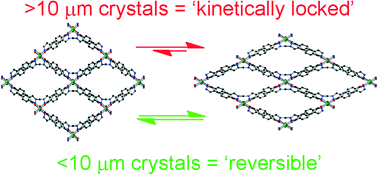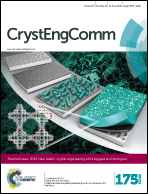Particle size effects in the kinetic trapping of a structurally-locked form of a flexible MOF†
Abstract
The application of metal–organic frameworks (MOFs) for gas storage, molecular separations and catalysis necessitates careful consideration of the particle size and structuralisation (e.g. pelletisation, surface-anchoring) of a material. Recently, particle size has been shown to dramatically alter the physical and structural properties of certain MOFs, but overall there is limited information on how the particle size affects the properties of flexible MOFs. Here we demonstrate that the particle size of a flexible MOF, specifically the as-synthesised form of [Cu(bcppm)H2O]·S (H2bcppm = bis(4-(4-carboxyphenyl)-1H-pyrazolyl)methane, S = solvent) (1), correlates with the rate of structural reorganisation from a “kinetically-trapped”, activated 3D form of this MOF to an “open” 2D form of the structure. We also outline two methods for synthetically reducing the particle size of 1 at room temperature, using 0.1 M NaOH (for two reaction times: 0.5 and 16 h) and with the sodium salt of the ligand Na2bcppm, producing crystals of 85 ± 15, 280 ± 14 and 402 ± 41 nm, respectively.

- This article is part of the themed collection: 2016 New talent

 Please wait while we load your content...
Please wait while we load your content...